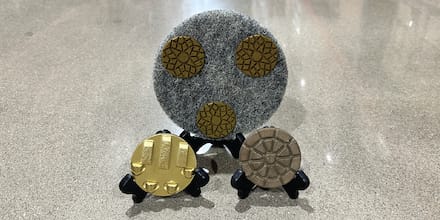Diamond tooling is critical in achieving superior results with a concrete floor. Whether polishing a new floor or rejuvenating an old one, the right diamond tools make all the difference.
From industrial facilities and manufacturing hubs to residential buildings and high-end corporate headquarters worldwide, floors made from concrete, especially polished concrete, are increasingly the contractors’ and customers’ preferred choice.
About Diamond Tooling
Diamond tooling cuts or polishes a concrete surface using one of the hardest materials on Earth: diamond grains. This is a distinct advantage compared to tools that use standard abrasives such as corundum and silicon carbide. The bond plays a significant role in how these diamonds are utilized.
- Metal-bonded diamonds are ideal for removing brittle adhesives.
- Carbide-bonded diamonds are perfect for tacky adhesives, leaving a smooth finish without damaging the concrete.
- PCD-bonded diamonds are aggressive in removing epoxy coatings and adhesives.
A soft-bonded diamond is necessary to achieve optimal productivity on hard concrete. Conversely, hard-bonded diamonds are better for soft concrete.
The segment of the tool, which refers to the raised part of the tool that holds the bond, is also a critical factor. More segments mean less head pressure, while a single segment bears all the pressure. The grit of the diamond tooling indicates the size of the diamonds in the bond, affecting the finish of the grind.
How to Use Diamond Grinding for Concrete Floors
Transforming a floor to its new, polished state begins with careful preparation. This process of cleaning and sanitizing requires removing all built-up residues or coatings. If these coatings are left on the surface, they can significantly hinder the success of any concrete polishing job.
The diamond grinding removal process is customized by:
- Type of residue present
- Concrete’s hardness
- Desired finish
- Square footage of the area
Determine Concrete Hardness
Choosing the correct diamond bond will dramatically increase productivity. So, determine if you’re working on soft, medium, or hard concrete. A Mohs Hardness Test can determine the hardness of the concrete, ranking it on a scale of one to 10
Best Tools for Grinding
The success of grinding a concrete floor is fundamentally linked to the choice of diamond tooling, a key component of any grinding equipment. Tailor your diamond tool to the specific characteristics of the concrete and the project’s desired outcome.
This section will overview some of the best tools available for grinding concrete floors, ensuring efficient work and high-quality finishes.
Diamabrush Mastic Removal Tool
- Removes mastic, carpet or tile adhesive, thin-set and thin-mil coatings like urethane or paint
- Uses rigid, exposed diamond-coated blades to grind stubborn coatings from concrete, creating a level floor with normal use
- Retains sharp cutting points over the life of the tool
- Designed to fit a wide variety of rotary flooring machines
- Low profile design enables the tool to travel over gaps in the concrete
- Apply water to eliminate dust and to flush debris away
- Money-saving replaceable blades
Husqvarna Piranha PCDs
- Rids concrete of hard-to-remove coatings, adhesives and screeds
- Specially formulated grade of Pirahna PCD diamond scraper inserts ensure maximum wear and productivity
- For use on the PG machinery range in conjunction with the Redi Lock system
- Single or double quarter-round PCD with protective diamond strip
- Tools can be re-tipped once worn out
HTC Metal-Bond T-Rex Series
- Removes coatings as opposed to grinding them, including thick coatings such as paint, epoxy, varnish, acrylic, glue, and screed residue
- Finer scratch pattern
- Leaves a good profile for laying down a new floor-covering
- T-Rex EZchange Gold allows the user to choose the correct grinding pressure needed
To achieve the desired finish efficiently and effectively, understand how to choose the right type of diamond tooling.
Diamond Tooling Trends
One of the hottest trends in diamond tooling today is transitional diamonds or hybrid diamond tooling. This approach combines the deep cutting and grinding action of metal tooling with the softer polishing action of resin tooling, streamlining the transition from grinding to polishing.
Additionally, diamond-impregnated pads are gaining traction for their ease of use and extended lifespan compared to traditional diamond tooling.
